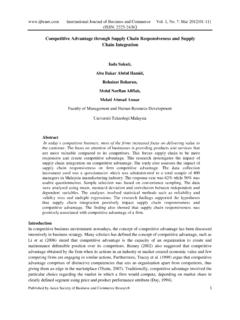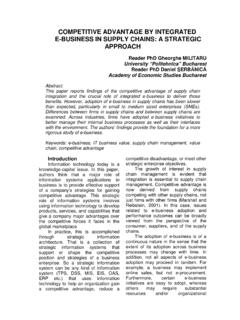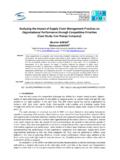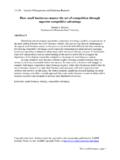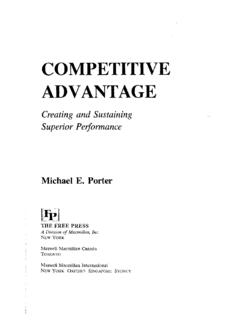Transcription of Moving Up the Value Chain: Staying Competitive in …
1 Moving Up the Value chain : Staying Competitive in the Global Economy MAIN FINDINGS Moving UP THE Value chain : Staying Competitive IN THE GLOBAL ECONOMY 3 OECD 2007 Foreword Globalisation raises many important challenges and is high on the policy agenda in many OECD countries. At the 2004 Ministerial Council Meeting, Ministers asked the OECD to shed light on issues related to the increased outsourcing and offshoring of production, since solid evidence to underpin policy discussion and formulation was scarce.
2 To help implement this mandate, the OECD Council decided at the end of 2004 on an allocation of the OECD s Central Priority Fund for a study including a systematic empirical overview of trends and developments on the globalisation of Value chains. The Committee on Industry, Innovation and Entrepreneurship (CIIE) provided guidance on the scope of this study. This document, presented to the OECD s 2007 Ministerial Council meeting, brings together some of the evidence on the globalisation of Value chains and identifies the most relevant policy issues in order to address concerns related to globalisation.
3 A compendium of the individual studies underlying this summary will be finalised later this year. 4 Moving UP THE Value chain : Staying Competitive IN THE GLOBAL ECONOMY OECD 2007 Table of Contents Global Value Chains and The Economic Effects of The Key Role of New Centres of Economic The Employment Effects of The Productivity Benefits of Structural Change Towards a Knowledge Policy Moving UP THE Value chain : Staying Competitive IN THE GLOBAL ECONOMY 5 OECD 2007 Global Value Chains and Globalisation Globalisation is not The rapid pace of the globalisation process has attracted much attention in recent years, but globalisation is not new.
4 The process of international economic integration has been underway for decades, facilitated by more open economic policies and trade liberalisation in a growing number of countries. Technical advances, notably in transport and communication, have lowered costs and also fostered globalisation. Trade and foreign direct investment (FDI) are still the key channels for international economic integration, with migration playing a more limited role. Technology transfer, through multinational enterprises and other channels, has also become an increasingly important factor.
5 But has some distinctive features today. The pace and scale of today s globalisation is without precedent and is associated with the rapid emergence of global Value chains as production processes become increasingly fragmented geographically. Information and communication technology (ICT) has made it possible to slice up the Value chain and perform activities in any location that can help reduce costs. The globalisation of Value chains results in the physical fragmentation of production, where the various stages are optimally located across different sites as firms find it advantageous to source more of their inputs globally.
6 This phenomenon has also been referred to in the literature as international production sharing and vertical integration of production and is closely linked to the growth of global production networks. Globalisation also increasingly involves foreign direct investment and trade in services, with many service activities becoming internationalised, especially since ICT has enabled the production of many services independent of a specific location. Another distinctive feature of current economic integration is that it is no longer restricted to OECD countries, but also involves large emerging global players like Brazil, China, India and Russia.
7 Global Value The globalisation of Value chains is motivated by a number of factors. One is the desire to increase efficiency, as growing competition in domestic and international markets forces firms to become more efficient and lower costs. One way of achieving that goal is to source inputs from more efficient producers, either domestically or internationally, and either within or outside the boundaries of the firm. Other important motivations are entry into new emerging markets and access to strategic assets that can help tap into foreign knowledge.
8 Notwithstanding these anticipated benefits, engaging in global Value chains also involves costs and risks for firms. 6 Moving UP THE Value chain : Staying Competitive IN THE GLOBAL ECONOMY OECD 2007 ..imply outsourcing and The fragmentation of the production process across various countries has given rise to considerable restructuring in firms including the outsourcing and offshoring of certain functions. Outsourcing typically involves the purchase of intermediate goods and services from outside specialist providers, while offshoring refers to purchases by firms of intermediate goods and services from foreign providers, or to the transfer of particular tasks within the firm to a foreign location (Figure 1).
9 Offshoring thus includes both international outsourcing (where activities are contracted out to independent third parties abroad) and international in-sourcing (to foreign affiliates). Figure 1. Outsourcing and offshoring Sources: OECD (2005g, 2006f)..of which some are relocations of existing activities. The growth of international sourcing has also resulted in the relocation of activities overseas, sometimes implying the total or partial closure of the production in the home country while at the same time creating or expanding affiliates abroad producing the same goods and services as in the host country.
10 More often, it is about the substitution of domestic stages of production by activities performed in foreign locations, with goods and services being exported from the host country to the home country. Relocation is not always interpreted in such a strict sense, and often encompasses different forms of internationalisation such as the opening of a new affiliate abroad to enhance market presence. While the different concepts may be easily defined, their measurement is more complex. Firms are sometimes reluctant to offer details on outsourcing and offshoring decisions, in particular on relocation.











